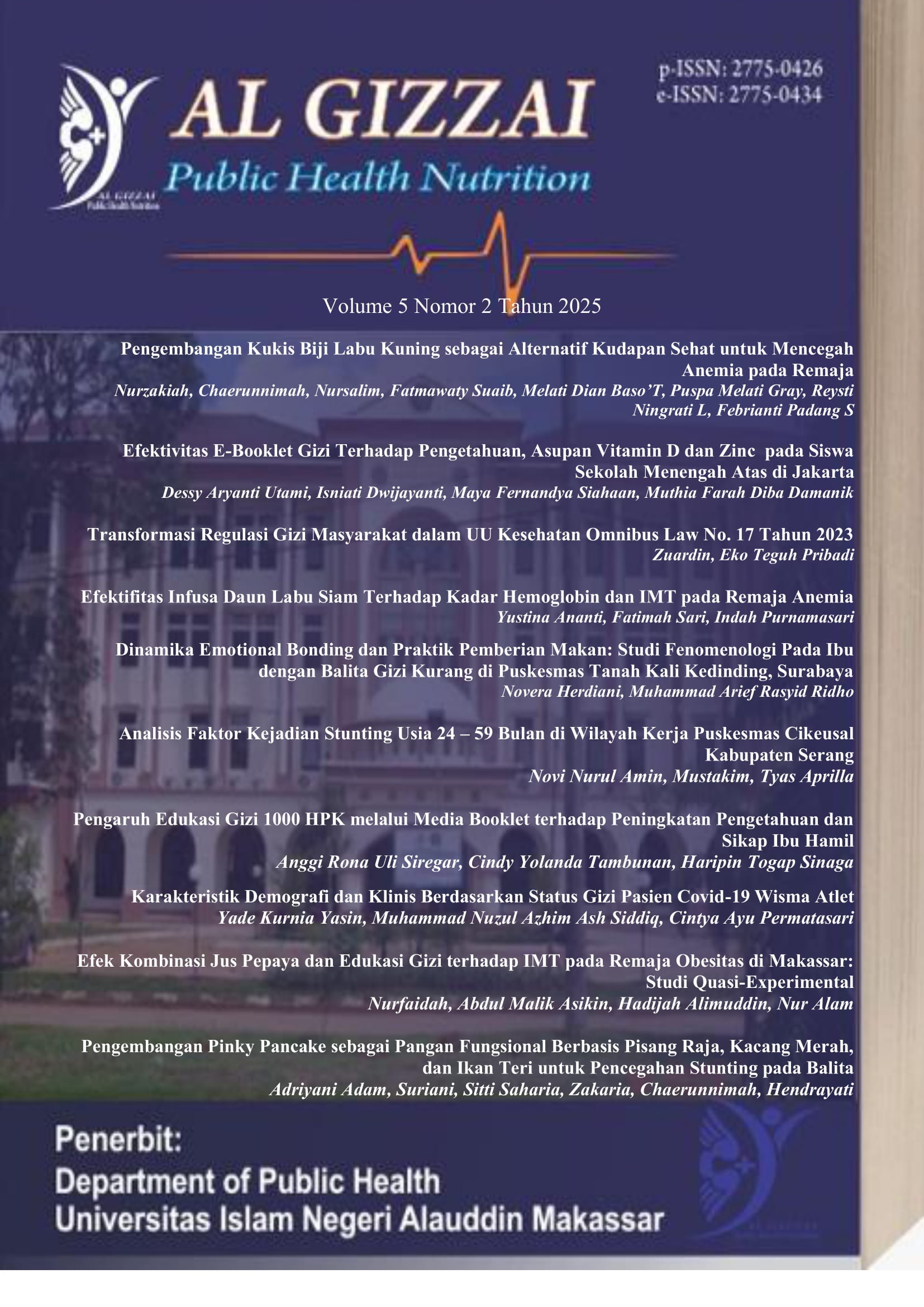Pengembangan Kukis Biji Labu Kuning sebagai Alternatif Kudapan Sehat untuk Mencegah Anemia pada Remaja
DOI:
https://doi.org/10.24252/algizzai.v5i2.55770Keywords:
Anemia, Remaja, Biji labu kuning, Kandungan gizi, KukisAbstract
Pendahuluan: Anemia pada remaja putri merupakan masalah kesehatan global, dan intervensi medis seperti pemberian Tablet Tambah Darah (TTD) saja mungkin tidak cukup untuk menurunkan prevalensi anemia. Biji labu, yang kaya akan zat gizi, dapat digunakan sebagai dasar camilan sehat untuk membantu mencegah anemia. Penelitian ini bertujuan untuk mengevaluasi kandungan zat gizi dan penerimaan panelis terhadap kukis biji labu berdasarkan aspek warna, aroma, tekstur, dan rasa. Penelitian eksperimental ini dilakukan di laboratorium kuliner Fakultas Kesehatan Masyarakat, Universitas Hasanuddin, Makassar.
Metodologi: Uji organoleptik pada 35 panelis yang merupakan mahasiswa. Penerimaan dinilai menggunakan skala hedonik, dan kandungan gizi dianalisis menggunakan Tabel Komposisi Pangan Indonesia.
Hasil: Hasil menunjukkan bahwa satu porsi (30 g) kukis biji labu memberikan 128,3% dari asupan harian zat besi yang direkomendasikan, 83% protein, dan 131,3% seng untuk remaja putri. Dalam hasil organoleptik, 45,8% panelis bersikap netral terhadap warna, 68,5% menyukai aroma, 65,7% menyukai tekstur, dan 74,3% menyukai atau sangat menyukai rasa. Nilai rata-rata daya terima kukis biji labu kuning secara keseluruhan untuk masing-masing atribut adalah: warna 3,2 ± 0,7; aroma 3,8 ± 0,7; tekstur 3,7 ± 0,9; dan rasa 4,0 ± 0,9.
Kesimpulan: Penerimaan tertinggi ada pada aspek rasa. Meskipun rasa kukis biji labu menunjukkan penerimaan yang baik, peningkatan warna menggunakan pewarna makanan alami dapat meningkatkan daya tarik visual.
References
Annisa, S. N., & Suryaalamsah, I. I. (2023). Formulasi Cookies dari Tepung Hati Ayam dan Tepung Kedelai Sebagai Makanan Sumber Zat Besi Pencegah Anemia Pada Remaja Putri. Muhammadiyah Journal of Nutrition and Food Science (MJNF), 4(1), 14. https://doi.org/10.24853/mjnf.4.1.14-27
Atanu, D., & Bhadra, P. (2020). A Review on Nutritional Anemia. Indian Journal of Natural Sciences, 10(59), 18674. (Google Scholar)
Aulia, A. F., Bahar, A., Ruhana, A., & Mayasari, N. R. (2024). Daya Terima Cookies Dengan Substitusi Tepung Kacang Merah Dan Penambahan Tepung Daun Kelor Sebagai Snack Sehat Untuk Remaja Putri Anemia Defisiensi Besi. Jurnal Ilmu Kesehatan dan Gizi, 2(3). https://doi.org/https://doi.org/10.55606/jig.v2i3.3108
Briguglio, M., Hrelia, S., Malaguti, M., Lombardi, G., Riso, P., Porrini, M., Perazzo, P., & Banfi, G. (2020). The central role of iron in human nutrition: From folk to contemporary medicine. Nutrients, 12(6), 1–17. https://doi.org/10.3390/nu12061761
Ceclu, L., Viorela Nistor, O., Danut Mocanu, G., & Gabriel Mocanu, D. (2020). Pumpkin-health benefits. Journal of Agroalimentary Processes and Technologies, 26(3), 241–246. (Google Scholar)
Cheng, M., McCulloch, M., Tran, R., Chang, J., Harris, S., Nakamura, T., & Pecore, S. (2016). Comparative Study On Practicability Of 9-Point Hedonic Scale And 5-Point Hedonic Scale For Beverages. Herbalife International Inc., Table 1, 9. (Google Scholar)
Cia, A., Annisa, H. N., & Lion, H. F. (2022). Asupan Zat Besi dan Prevalensi Anemia pada Remaja Usia 16-18 Tahun. Window of Health : Jurnal Kesehatan, 4(2), 144–150. https://doi.org/10.33096/woh.vi.248
Dotto, J. M., & Chacha, J. S. (2020). The potential of pumpkin seeds as a functional food ingredient: A review: Biofunctional ingredients of pumpkin seeds. Scientific African, 10, e00575.
https://doi.org/10.1016/j.sciaf.2020.e00575
Godrich, J., Rose, P., Muleya, M., & Gould, J. (2023). The effect of popping, soaking, boiling and roasting processes on antinutritional factors in chickpeas and red kidney beans. International Journal of Food Science and Technology, 58(1), 279–289. https://doi.org/10.1111/ijfs.16190
Habtegiorgis, S. D., Petrucka, P., Telayneh, A. T., Shitu Getahun, D., Getacher, L., Alemu, S., & Birhanu, M. Y. (2022). Prevalence and associated factors of anemia among adolescent girls in Ethiopia: A systematic review and meta-analysis. PLoS ONE, 17(3 March), 1–11. https://doi.org/10.1371/journal.pone.0264063
Karani, R. A. R., & Oktafa, H. (2021). Kajian Pembuatan Cookies dengan Penambahan Tepung Daun Kelor dan Biji Wijen untuk Mencegah Anemia. HARENA: Jurnal Gizi, 1(3), 118–127. https://doi.org/https://doi.org/10.25047/harena.v1i3.2690
Kementerian Kesehatan RI. (2018). Laporan Riskesdas 2018 Nasional.
Kementerian Kesehatan RI. (2023). Survei Kesehatan Indonesia (SKI)) 2023.
Khobibah, K., Nurhidayati, T., Ruspita, M., & Astyandini, B. (2021). Anemia Remaja Dan Kesehatan Reproduksi. Jurnal Pengabdian Masyarakat Kebidanan, 3(2), 11. https://doi.org/10.26714/jpmk.v3i2.7855
Permenkes. (2019). Permenkes. In Peraturan Menteri Kesehatan Republik Indonesia Nomor 28 Tahun 2019 Tentang Angka Kecukupan Gizi yang Dianjurkan Untuk Masyarakat Indonesia: Vol. Nomor 15.
Shaikh, A., Ahmad, F., Teoh, S. L., Kumar, J., & Yahaya, M. F. (2023). Honey and Alzheimer’s Disease—Current Understanding and Future Prospects. Antioxidants, 12(2), 1–33. https://doi.org/10.3390/antiox12020427
Srivastava, S., Kumar, P., Paul, R., & Debnath, P. (2022). Effect of change in individual and household level characteristics on anemia prevalence among adolescent boys and girls in India. BMC Public Health, 22(1), 1–10. https://doi.org/10.1186/s12889-022-13863-w
Triandita, N., Maifianti, K. S., Rasyid, M. I., Yuliani, H., & Anggraeni, L. (2020). Pengembangan Produk Pangan Fungsional Dalam Meningkatkan Kesehatan dan Kesejahteraan Masyarakat di Desa Suak Pandan Aceh Barat. Logista: Jurnal Ilmu Pengabdian Masyarakat, 4(2), 457–464. https://doi.org/https://doi.org/10.25077/logista.4.2.457-464.2020
Weldeyohanis Gebremariam, F., Tadesse Melaku, E., Sundramurthy, V. P., & Woldemichael Woldemariam, H. (2024). Development of functional cookies form wheat-pumpkin seed based composite flour. Heliyon, 10(2), e24443. https://doi.org/10.1016/j.heliyon.2024.e24443
Wessels, I., Fischer, H. J., & Rink, L. (2021). Dietary and Physiological Effects of Zinc on the Immune System. Annual Review of Nutrition, 41, 133–175. https://doi.org/10.1146/annurev-nutr-122019-120635
WHO. (2023). Prevalence of anaemia in women of reproductive age ( aged 15-49 ) (%) Location type Prevalence of anaemia in women of repro ... The Global Health Observatory, 2023. https://www.who.int/data/gho/data/indicators/indicator-details/GHO/prevalence-of-anaemia-in-women-of-reproductive-age-(-)
Downloads
Published
How to Cite
Issue
Section
License
Copyright (c) 2025 Nurzakiah Nurzakiah, Chaerunnimah, Nursalim, Fatmawaty Suaib, Melati Dian Baso’T, Puspa Melati Gray, Reysti Ningrati L, Febrianti Padang S

This work is licensed under a Creative Commons Attribution-NonCommercial-ShareAlike 4.0 International License.
Authors retain copyright and grant the journal right of first publication with the work simultaneously licensed under a Creative Commons Attribution-NonCommercial-ShareAlike 4.0 International License that allows others to share the work with an acknowledgment of the work's authorship and initial publication in this journal.
Authors are able to enter into separate, additional contractual arrangements for the non-exclusive distribution of the journal's published version of the work (e.g., post it to an institutional repository or publish it in a book), with an acknowledgement of its initial publication in this journal.
Authors are permitted to publish their work online in third parties as it can lead to wider dissemination of the work.















